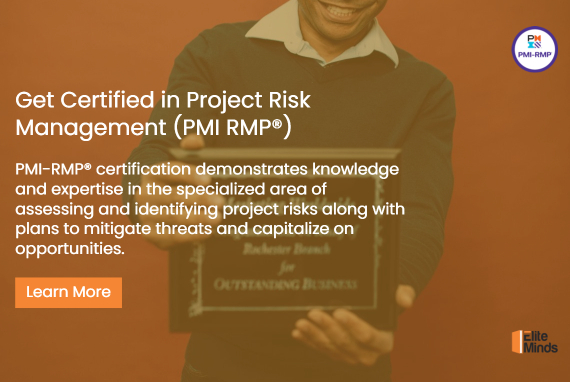The PMI-RMP addresses the domain of risk management within the context of projects, programs, and portfolios which is the primary, and often the only context in which professionals do risk management. Specifically, the exam pertains to tasks related to everything from building a risk strategy into monitoring and closing risks. I am listing below the PMI-RMP exam hot topics where most of the exam questions come from:
- Risk Response Strategies. Project managers should work to eliminate the threats before they occur. Similarly, the project managers should work to ensure that opportunities occur. Likewise, the project manager is also responsible to decrease the probability and impact of threats and increase the probability and impact of opportunities. For the threats that cannot be mitigated, the project manager needs to have a contingency plan and also a response plan if contingencies do not work. It is not required to eliminate all the risks of the project due to resource and time constraints. A project manager should review risk throughout the project. Planning for risks is iterative. Qualitative risk, quantitative risk, and risk response planning do not end ones you begin work on the project. Generally, risk response plans are required for risks that are high in both probability and impact. For example, a nuclear power repair project might have response plans developed for radiation exposure events. Risk response strategies for threats include: Avoid, mitigate, transfer, accept, and escalate. For opportunities, it includes: Exploit, enhance, share, accept, and escalate. Expect 10+ questions in the PMI-RMP exam asking you about the best strategy to use in a specific scenario.
- Risk in Contracts. A typical question in the CAMP/PMP/PMI-RMP exams would present a procurement scenario, the scenario would provide some details about the contract the project manager is using, and the question would then ask who has more risk in the described scenario – the buyer or the Seller. You will have to first understand which type of contract is being described in the situation and then answer the question accordingly. PMBOK® guide talks about three basic types of contracts. The Three basic types of contracts are further divided into few sub-types. In this article am going to list all what you need to know about the contract types for the PMP/PMI-RMP exam. Below am listing the contracts in a way you can easily understand who carries more risk in each type of contract, the buyer or the seller. The risk on the buyer will be the maximum at a Cost-Plus Percentage of Costs (CPPC) contract, the seller will carry the maximum risk in a fixed price contract. Buyers’ cost risk from the various contract types (from highest to lowest): Cost plus percentage of cost –> Cost plus fixed fee –>Cost plus award fee –> Cost plus incentive fee –>Time & material –>Fixed price economical price adjusted —> Fixed price incentive fee –> Firm fixed price.
- Monte Carlo Simulation. It is a detailed, computer-intensive simulation approach that allows people to account for risk in quantitative analysis and decision making. It is determining the value and probability of possible outcomes of a project objective such as a project schedule or cost estimate. It computes the schedule or cost estimate many times, using inputs drawn at random from ranges specified with probability distribution functions (Triangular distribution, Beta distribution or other) for schedule activity durations or cost line items. For the PMI-RMP exam, expect 3-4 questions asking you to read the results of conducting a Monte Carlo simulation on a specific project.
- Risk Register and Risk Report Updates. The risk register captures details of identified individual project risks. The results of Perform Qualitative Risk Analysis, Plan Risk Responses, Implement Risk Responses, and Monitor Risks are recorded in the risk register as those processes are conducted throughout the project. The risk register may contain limited or extensive risk information depending on project variables such as size and complexity. The risk report presents information on sources of overall project risk, together with summary information on identified individual project risks. The risk report is developed progressively throughout the Project Risk Management process. The results of Perform Qualitative Risk Analysis, Perform Quantitative Risk Analysis, Plan Risk Responses, Implement Risk Responses, and Monitor Risks are also included in the risk report as those processes are completed. For the PMI-RMP exam context, it’s important to be aware of the risk register and risk report updates after implementing each risk management process.
- Risk Management Plan. It is risk management plan is a subsidiary plan for how risk management will be done on a project, who should be involved, when risk management activities should be done and how frequently they should be done. It an important plan as it explains how Risk will be managed in the project and memorize that it is the main output of the Plan Risk management process. For the PMI-RMP exam, you need to memorize the major items which a risk management plan must include.
- Advanced tools and techniques in risk management, as per the practice standard for risk management, there are additional tools and techniques used for risk management, like the cause-and-effect diagrams, affinity diagrams, pre-mortem, analytical hierarchy process, and failure mode effect analysis. Expect not less than 20 exam questions about the advanced risk management tools and techniques, specifically from the risk identification process.
- Earned Value Management. Earned Value Management, earned value is used in performance reviews to measure project performance against the scope, schedule and cost baselines. Earned value analysis (EVA) is an analysis technique that compares the actual schedule and cost to the performance measurement baseline. Earned value integrates cost, schedule and scope (work done). Can be used to forecast future performance and project completion dates and costs. EVM compares what you’ve received or produced to what you’ve spent. The EVM continuously monitors the planned value, earned value, and actual costs expended to produce the work of the project. To perform the EVM calculations, you need to first gather the three measurements mentioned earlier: the planned value (PV), actual cost (AC), and earned value (EV). Expect 3-5 questions in the exam about this performance review technique.
- Contingency reserves are money added to the project cost estimates by the project manager for uncertain events / risks that might happen (also known as “known unknowns”). A reserve is an amount of time and/or cost added to the project to account for risks. There are two types of reserves: Contingency reserves are money added to the project cost estimates by the project manager for uncertain events / risks that might happen (also known as “known unknowns”). Contingency reserves are the finance for the project cost estimates by the project manager to deal with uncertain events/risks that may happen i.e known unknowns. The contingency reserve is assigned for activities, work package, or a project. For the PMI-RMP exam, you need to understand the difference between contingency and management reserves, and you need to understand how to determine the required reserves for a project.
- Risk score is a calculated number (score) that reflects the severity of a risk due to some factors. Typically, project risk scores are calculated by multiplying probability and impact though other factors, such as weighting may be also be part of calculation. Expect 2-3 questions in the exam about the risk score definition and calculation.
In order to get prepared for the PMI RMP exam, I advise you to check our blog article that lists some of the hight quality mock exams in the online market, you can access it from the link here.
Good Luck in your Journey!

.jpg)
.jpg)
.jpg)


